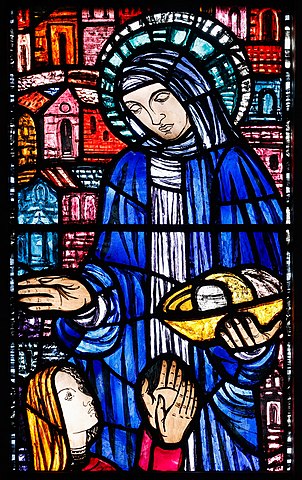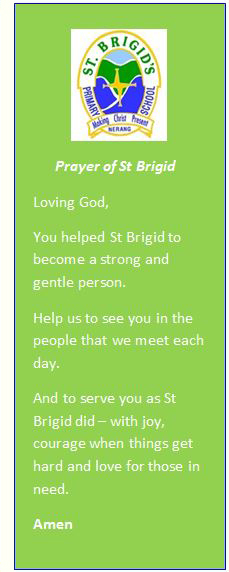
The Vision for Religious Education as stated in the Religious Education Curriculum of Brisbane Catholic Education is a clear expression what St Brigid’s hopes for its students in terms of their religious literacy and faith formation.
“The schools and colleges of the Archdiocese of Brisbane aspire to educate and form students who are challenged to live the gospel of Jesus Christ and who are literate in the Catholic and broader Christian tradition so that they might participate critically and authentically in faith contexts and wider society”
The following model identifies two distinct, but complementary, dimensions of Religious Education in our school.
"Loughrea St. Brendan's Cathedral West Aisle Window Saint Brigid by Evie Hone Detail 2019 09 05" by Andreas F. Borchert is licensed under CC BY-SA 4.0.

The Vision for Religious Education challenges students to be a religious voice in the world. Through vibrant and engaging Religious Education, we aspire of our students to become active constructors of culture rather than passive consumers. At St Brigid’s we acknowledge that parents are the prime educators of their children and we aim to work with parents in the Religious Education of their child with the assumption that the above model will not be limited to the primary school context rather that these elements will be developed over a whole lifetime.
 St Brigid's School Religious Education Program Reviewed August 2020.pdf outlines the principles and processes involved in planning for quality learning opportunities in Religion that promote equity and excellence for our students. Our aim is that all students develop as confident, creative learners who can participate in society as empowered citizens who can shape their world, inspired by the Gospel of Jesus Christ.
St Brigid's School Religious Education Program Reviewed August 2020.pdf outlines the principles and processes involved in planning for quality learning opportunities in Religion that promote equity and excellence for our students. Our aim is that all students develop as confident, creative learners who can participate in society as empowered citizens who can shape their world, inspired by the Gospel of Jesus Christ.
Whole School Values
Our whole school values are integral to the St Brigid's Way. They are a guiding light for all in our school community and are play a pivotal role in our efforts to strengthen our Catholic Identity. Each week, we focus on one value and this is cemented through classsrom and incidental teaching moments, whole school and classroom prayer and by providing a pastoral avenue in line with our Positive Behaviour for Learning Policy.
At St Brigid's, our four core values of FAITH, COMPASSION, LOVE AND PEACE highlight the the charism of St Brigid who rests in Celtic origins. Three sub-values extend from each core value. The link below lists our Values and how we live and action these each day in our school.
 THE ST BRIGID'S WAY.pdf
THE ST BRIGID'S WAY.pdf
 St Brigid's Way Whole School Values .pdf
St Brigid's Way Whole School Values .pdf
Religious Life of the School
With Christ at the centre of all we do, our staff take every opportunity to be the face of the Catholic Church for families at our school, realising that many families will experience the formal life of the Church exclusively through their connection with our school. Hospitality, authenticity and inclusivity inform decisions made with and for learners and their families during their time in our community. Families who are less familiar with Catholic Christian traditions can be unsure about how to participate fully in the religious dimension of school life. To address this we seek to provide support and information for families to help them participate more fully in the life of our school.

Contemporary Context for Religious Education
Religious Education in the Archdiocese of Brisbane seeks to reflect a Catholic Christian worldview that integrates faith, life and culture. At St Brigid’s, we seek to embrace a perspective that reflects the multi-faith context and reality of contemporary schools and colleges.
Student demographics are used as a starting point to shape the pedagogical and planning choices made by staff when implementing the curriculum. These decisions are further informed by the societal, ecclesial, educational and digital contexts of contemporary life and education. For many of our students this exposes them to a broader perspective on life and learning, allowing them to access a variety of quality learning experiences to nurture lifelong learning. Our beliefs about learners and learning in Religious Education are informed by quality professional learning, which in turn directs the curriculum choices made by teachers.

At St Brigid’s, we are responsive to the needs and religious backgrounds of our students and the contemporary contexts for learning in the Religion classroom. Our vision aligns with the Archdiocesan aspiration for all students: to educate students for lifelong, critical participation within society as people who are challenged by the gospel of Jesus Christ to live wisely and authentically in communion with God and with others. We seek to do so in such a way as to nurture the faith development of students, ever mindful of the diversity of religious backgrounds and understandings represented in our community.
Teaching and Learning
As a community, we strive to live the charism of St Brigid: charity, strength and hospitality, a love of learning and love for God. Our school motto ‘Making Christ Present’ is a regular reminder to all at St Brigid’s that the knowledge we seek in the Religion Curriculum serves a purpose only when it informs our relationships with God and with others. Opportunities to involve children in application of their classroom learning to life in our community and beyond are planned for each term.
.jpg)
St Brigid’s School, Nerang Student Data 2020
In the 2020 school year, 38.6% of St Brigid’s students identify as Catholic. This has significant implications for the planning and teaching of Religious Education at our school. Up to half of every cohort comes to us with little or no background in the Catholic faith, and little experience with its beliefs, teachings, traditions or rituals. They may come from a family that aspires to these things, or may lack support for their learning and experiences in these areas. When planning for student learning in Religious Education, teachers access relevant data and consider the individuals and their backgrounds in order to differentiate curriculum delivery and address individual needs, allowing all children to have the opportunity to fully engage with the curriculum.
|
Student Religion Name |
Student Religion Percentage |
| Catholic | 38.6% |
| No religion | 30.2% |
| Not stated | 8.7% |
Other Religion
| 2.3% |
| Other Christian | 20.1%
|
Table 1: Student Religious Background
© Brisbane Catholic Education, St Brigid’s Catholic Primary School (2023)
© Brisbane Catholic Education, (2023)